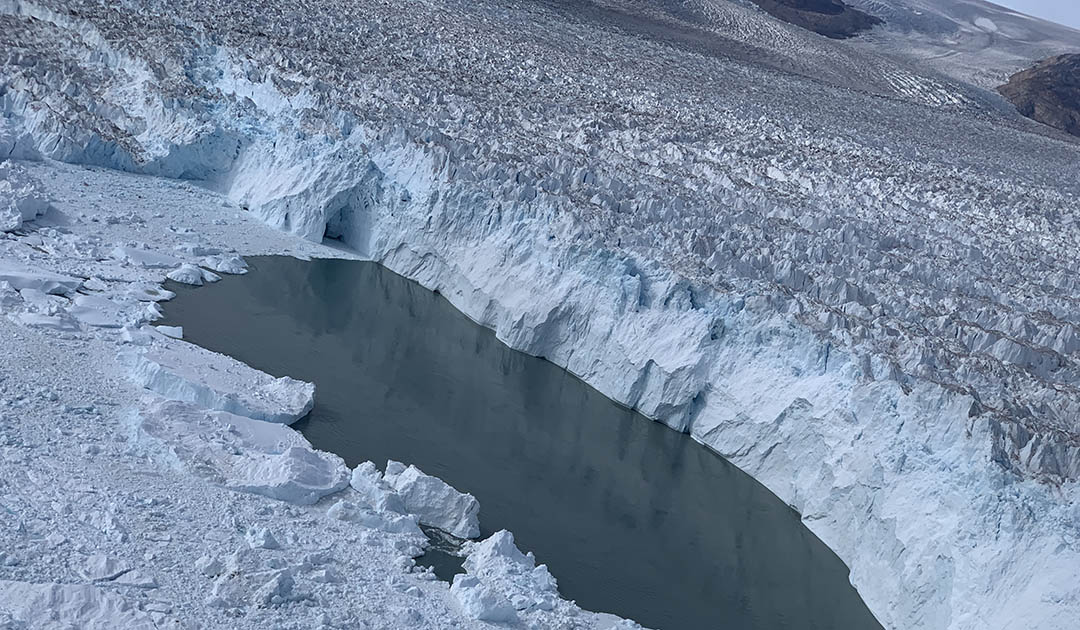
Greenland is losing huge amounts of ice due to global warming, especially through its marine-terminating glaciers. One of these tidewater glaciers is the Helheim Glacier, in south-east Greenland. Scientists at Pennsylvania State University have now published a study examining the relationship between the occurrence of meltwater plumes off the edge of the glacier and iceberg breakup. The study appeared in the Journal of Glaciology.
The Helheim Glacier is one of the most massive in Greenland and the fastest flowing outlet glacier in East Greenland, flowing into Sermilik Fjord. In the terminal area, it has a width of about six kilometers and its front is about 100 meters high, in some places even up to 300 meters. According to the authors, during warm phases there is so much meltwater draining from underneath the glacier that the lighter freshwater rises to the sea surface in front of the glacier, forming an open water surface in the mélange of icebergs, ice chunks and seawater.

(a) Helheim Glacier is located on the southeast coast of Greenland and flows into Sermilik Fjord. (b) Several meltwater lakes and water-filled crevasses are visible on the Sentinel-2 satellite image of the terminal region of the glacier (colored outlines). The black arrows mark the flow direction of the ice. (c) Drone image of the calving front and ice mélange in August 2019. Figure: Melton et al. 2022
Mit Hilfe von hochauflösenden Satellitenbildern und Tausenden Zeitrafferaufnahmen von Kameras, die von 2011 bis 2019 rund um den Gletscher stationiert waren, verfolgten die Wissenschaftler die Schmelzwasserfahnen und entdeckten dabei, dass in der Nähe dieser Süßwasserlinsen keine großen Eisberge abbrachen. «Wir sahen, dass viele Eisberge kalbten, dann hörten sie auf, wenn die Fahne sichtbar war, und fingen wieder an, wenn die Fahne verschwand», sagt Sierra Melton, Doktorandin der Geowissenschaften an der Pennsylvania State University und Haupt-Autorin der Studie. «Und wenn das Kalben auftrat, geschah es weit weg von den Schwaden. Sie waren immer räumlich und zeitlich voneinander getrennt.»
In the early 1970s, the Helheim Glacier extended to the Sermilik Fjord, with its ice tongue floating on the water, meaning it was an ice shelf. Today its front is about 7.5 kilometers inland and steep rock cliffs are now visible to the right and left of the ice stream as it has also lost massively in thickness.
Calving glaciers are responsible for about half of the ice loss from the Greenland ice sheet, contributing significantly to sea level rise, the authors said.
“Sierra’s work, including this paper, is an important contribution to the larger effort to understand how iceberg calving really works and what controls its speed, so we can do a better job of projecting what will happen in Greenland, as well as Antarctica, and what that will mean for sea-level rise and costal people,” said Richard Alley, a professor of geosciences at Pennsylvania State University, Melton’s supervisor and co-author of the study.

The researchers’ findings suggest that changes in hydrology and pressure beneath the glacier are responsible for the link between meltwater discharge and calving. The authors explain that, during the melt season, water collects in crevasses and forms lakes on the glacier surface. Some of the meltwater drains down to the glacier bed, where it fills cavities and creates a network between them.
“The way a subglacial drainage system evolves is if there’s not very much water under the glacier, then there is low water pressure,” Melton said. “As the water increases under the glacier, the pressure starts to increase with it.”
The higher the water pressure at the glacier bed, the faster the glacier flows toward the sea and cracks can develop in the ice, making it more susceptible to ice breakup. According to the authors, under this pressure, and if there is enough water at the glacier bed, meltwater can carve channels in the bottom of the ice that direct water to the sea and act as a kind of pressure relief valve that reduces the water pressure under the glacier ice. These channels can release so much fresh water that it becomes visible as open water in a sea of ice slurry.
The video impressively shows a large calving event from 2013. Video: Hans Henrik Tholstrup
«Wir glauben, dass dieser niedrigere Druck das große Kalben verhindert, weil sich die Risse im Boden des Eises nicht bilden können», so Melton. «Im Grunde sollte also das System, das die Existenz der Schmelzwasserfahne unterstützt, das Kalben unterdrücken.»
Julia Hager, PolarJournal
More about this topic





